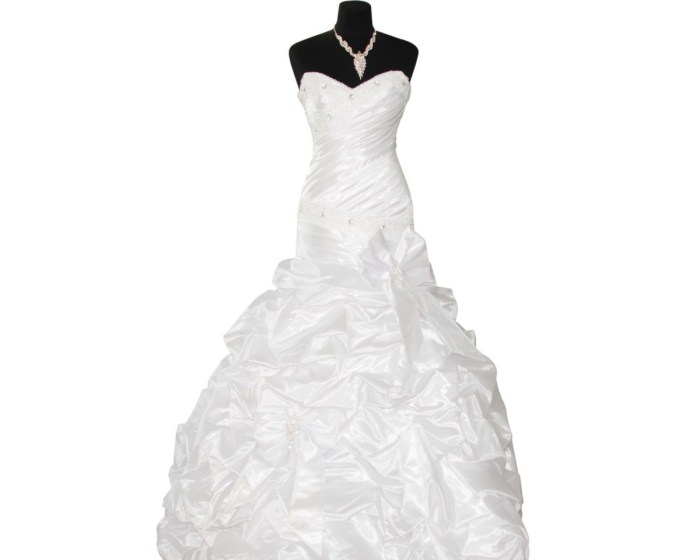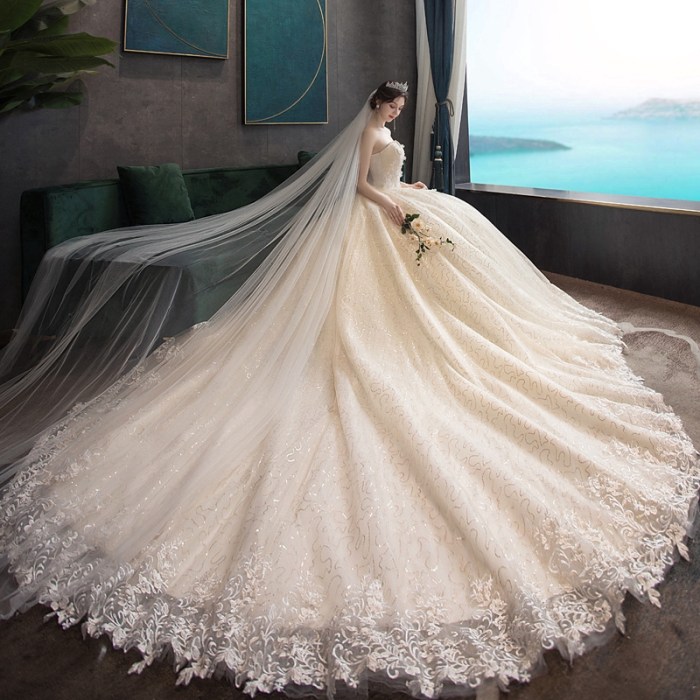Understanding “Dress for Wedding Gown”
Dress for wedding gown – The phrase “dress for a wedding gown” subtly differs from “wedding dress.” While both refer to attire for a wedding, “dress for a wedding gown” implies a more specific context, often focusing on the selection and preparation process rather than the garment itself. It suggests the act of choosing, fitting, and accessorizing the gown, encompassing the entire experience of getting ready for the wedding day.
Interpretations and Contexts of “Dress for Wedding Gown”
The phrase can be interpreted in several ways. It might refer to choosing a dress to wear as a guest to a wedding, or it might describe the process of selecting and preparing the bride’s wedding gown. The context usually clarifies the intended meaning. For instance, a bridal shop might use it in the context of bridal consultations, while a wedding blog might use it to describe a guest’s outfit selection.
Styles and Silhouettes of Wedding Gowns
The term encompasses a wide range of styles and silhouettes, from classic A-line and ballgown designs to more modern mermaid and sheath styles. Each silhouette offers a unique aesthetic and flatters different body types. Fabric choice significantly impacts the overall look and feel, with flowing fabrics like chiffon often used for A-line gowns and structured fabrics like satin for mermaid gowns.
Fabric and Materials in Wedding Gowns
The fabric selection for a wedding gown significantly influences its drape, texture, and overall aesthetic. Different fabrics are better suited for different seasons and styles.
Fabric Comparison for Wedding Gowns, Dress for wedding gown
Silk, lace, satin, tulle, and organza are popular choices, each offering unique qualities. Silk, known for its luxurious drape and sheen, is ideal for formal weddings, particularly in warmer climates. Lace adds intricate detail and romance, while satin provides a sleek, elegant look. Tulle offers volume and texture, often used in ballgown styles, and organza adds a crisp, structured feel.
Heavier fabrics like brocade might be chosen for winter weddings.
Fabric Choice and its Impact
For example, a flowing chiffon gown will create a bohemian feel, suitable for a beach or garden wedding. A structured satin gown will give a more sophisticated and formal look, perfect for a ballroom setting. Lace can add a touch of vintage charm, while tulle can create a dramatic, princess-like effect.
Design Elements and Styles of Wedding Gowns
Several key design elements contribute to a wedding gown’s aesthetic appeal. These include necklines, sleeves, train length, embellishments, and overall silhouette.
Wedding Gown Design Elements
| Neckline | Sleeves | Train Length | Example |
|---|---|---|---|
| Sweetheart | Strapless | Chapel | Classic, romantic look |
| V-neck | Long sleeves | Court | Elegant and sophisticated |
| High neck | Short sleeves | Sweep | Modern and minimalist |
| Off-the-shoulder | Cap sleeves | Cathedral | Romantic and dramatic |
Popular Wedding Gown Styles

Source: thrfun.com
- A-line: Flattering on most body types, featuring a fitted bodice and a gradually widening skirt.
- Ballgown: Dramatic and voluminous, with a fitted bodice and a full, wide skirt.
- Mermaid: Form-fitting through the hips and flaring out at the knees, creating a dramatic silhouette.
- Sheath: Simple and elegant, featuring a straight, close-fitting silhouette.
- Empire waist: Features a high waistline that falls just below the bust, creating a flowing, romantic look.
Accessories and Styling for Wedding Gowns: Dress For Wedding Gown
Accessories play a crucial role in complementing a wedding gown and enhancing the overall bridal look. The choice of accessories should align with the gown’s style and the wedding’s theme.
Accessory Options for Different Wedding Styles
- Veils: Vary in length and style (e.g., cathedral, chapel, birdcage).
- Jewelry: Necklaces, earrings, bracelets, and tiaras can add sparkle and elegance.
- Shoes: Heels or flats, depending on the gown’s style and the bride’s preference.
- Gloves: Can add a touch of vintage glamour or sophistication.
- Handbags: Small clutches or purses for carrying essentials.
Hair and Makeup Styling
The hairstyle and makeup should complement the gown and overall aesthetic. An updo might suit a more formal gown, while loose waves might work better with a bohemian style. Makeup should enhance the bride’s natural features without overpowering the gown.
Visual Representation of Wedding Gowns (Descriptive Only)

Source: shopee.ph
Visual descriptions of wedding gowns help in understanding the design elements and overall look.
A Flowing A-Line Gown
Imagine a flowing A-line gown crafted from ivory silk chiffon, delicately adorned with intricate Alençon lace appliqués cascading down the skirt. The sweetheart neckline is subtly accented with delicate beading, while the chapel-length train adds a touch of elegance. The overall effect is romantic and ethereal.
Beach Wedding Gown
Picture a breezy, lightweight gown made from creamy white cotton lace. The simple A-line silhouette is perfect for a relaxed beach setting. The short sleeves and modest neckline offer comfort and practicality while maintaining a chic and elegant feel. Minimal embellishments allow the natural beauty of the fabric and the setting to take center stage.
Formal Evening Wedding Gown
Envision a breathtaking ballgown in luxurious ivory silk satin. The fitted bodice is intricately embroidered with sparkling crystals and pearls, creating a dazzling effect. The full skirt flows gracefully to the floor, creating a dramatic silhouette. A long, cathedral-length veil completes the look, adding an air of regal elegance.
Budget and Price Considerations for Wedding Gowns
The cost of a wedding gown varies greatly depending on several factors.
Factors Influencing Wedding Gown Cost
Fabric type, embellishments (beading, embroidery, lace), designer brand, and the level of craftsmanship all contribute to the final price. Designer gowns can range from several thousand dollars to tens of thousands, while more affordable options can be found at bridal boutiques and online retailers.
Price Ranges for Wedding Gowns
Price ranges vary significantly. Budget-friendly options might start around $500, while mid-range gowns could cost between $1,000 and $3,000. High-end designer gowns can easily exceed $5,000.
Finding Affordable Wedding Gowns
Consider shopping during sample sales, looking for off-season deals, or opting for simpler designs with fewer embellishments. Renting a gown or buying a pre-owned dress can also be cost-effective options without compromising on style or quality.
Questions and Answers
What’s the difference between a wedding dress and a dress for a wedding gown?
A “wedding dress” typically refers to the bride’s main gown. “Dress for a wedding gown” implies a more specific garment, perhaps a secondary dress for the reception or a different outfit for a wedding-related event.
How far in advance should I start looking for a wedding dress?
Ideally, begin your search 9-12 months before the wedding to allow ample time for alterations and potential delays.
What should I consider when choosing a wedding dress for a particular venue?
Consider the venue’s formality (beach, church, ballroom) and the season. A flowing gown might be ideal for a beach wedding, while a more structured gown suits a formal setting.
How can I find affordable wedding gowns?
Consider sample sales, consignment shops, online retailers, and renting a gown. Prioritize fabrics and embellishments that fit your budget.
